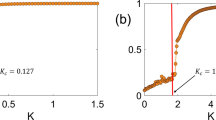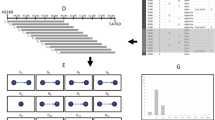Abstract
Dynamic adaptation is a key feature of brains helping to maintain the quality of their performance in the face of increasingly difficult constraints. How to achieve high-quality performance under demanding real-time conditions is an important question in the study of cognitive behaviors. Animals and humans are embedded in and constrained by their environments. Our goal is to improve the understanding of the dynamics of the interacting brain–environment system by studying human behaviors when completing constrained tasks and by modeling the observed behavior. In this article we present results of experiments with humans performing tasks on the computer under variable time and resource constraints. We compare various models of behavior generation in order to describe the observed human performance. Finally we speculate on mechanisms how chaotic neurodynamics can contribute to the generation of flexible human behaviors under constraints.
Similar content being viewed by others
References
Clark A (1997) Being there: putting brain, body, and world together again. The MIT Press, Cambridge, MA
Clark A (1999) Where brain body and world collide. Cogn Syst Res 1(1):5–17
Freeman WJ (1999) How brains make up their minds. Weidenfeld & Nicolson, London
Freeman WJ, Barrie JM (2000) Analysis of spatial patterns of phase in neocortical gamma eegs in rabbit. J Neurophysiol 84:1266–1278
Freeman WJ, Holmes MD, West G, Vanhatalo S (2006) Fine spatiotemporal structure of phase in human intracranial EEG. Clin Neurophysiol 117(6):1228–1243
Freeman WJ, Kozma R, Werbos PJ (2000) Biocomplexity: adaptive behavior in complex stochastic dynamical systems. BioSystems 59:109–123
Harter D, Kozma R (2001a) Models of ontogenetic development for autonomous adaptive systems. In: Proceedings of the 23rd annual conference of the cognitive science society. Edinburgh, Scotland, pp 405–410
Harter D, Kozma R (2001b) Task environments for the dynamic development of behavior. In: Proceedings of the intelligent systems design and applications 2001 workshop (ISDA 2001). San Francisco, CA, pp 300–309
Kelso JAS (1995) Dynamic patterns: the self-organization of brain and behavior. The MIT Press, Cambridge, MA
Kirsh D, Maglio P (1992) Reaction and reflection in tetris. In: Hendler J (Ed) Artificial intelligence planning systems: proceedings of the first annual international conference (AIPS92). Morgan Kaufman, San Mateo, CA, pp. 283–284.
Kirsh D, Maglio P (1994) On distinguishing epistemic from pragmatic action. Cogn Sci 18:513–549
Kozma R, Freeman WJ (1999) A possible mechanism for intermittent oscillations in the KIII model of dynamic memories – the case study of olfaction. In: Proceedings of the international joint conference on neural networks IJCNN 1999, pp 52–57
Kozma R, Freeman WJ (2000) Encoding and recall of noisy data as chaotic spatio-temporal memory patterns in the style of the brains. In: Proceedings of the IEEE/INNS/ENNS international joint conference on neural networks (IJCNN’00). Como, Italy, pp 5033–5038
Kozma R, Freeman WJ (2001) Chaotic resonance – methods and applications for robust classification of noisy and variable patterns. Int J Bifurc Chaos 11(6):1607–1629
Kozma R, Freeman WJ (2002) Classification of EEG patterns using nonlinear neurodynamics and chaos. Neurocomputing 44–46:1107–1112
Kozma R, Harter D, Achunala S, (2002) Action selection under constraints: dynamic optimization of behavior in machines and humans. In: Proceedings of the IEEE/INNS/ENNS international joint conference on neural networks (IJCNN’02). Washington, DC, pp 2574–2579
Skarda CA, Freeman WJ (1987) How brains make chaos in order to make sense of the world. Behav Brain Sci 10:161–195
Thelen E, Smith LB (1994) A dynamic systems approach to the development of cognition and action. The MIT Press, Cambridge, MA
West RL, Lebiere C (2001) Simple games as dynamic, coupled systems: randomness and other emergent properties. Cogn Syst Res 1(4):221–239
Acknowledgments
This work has partly supported by NASA Research Grant NCC-2-1244. Discussions with Drs. Philip Wolf and Stan Franklin were helpful and greatly appreciated. Advice by Shulan Lu concerning statistical evaluation of data is also highly appreciated.
Author information
Authors and Affiliations
Corresponding author
Rights and permissions
About this article
Cite this article
Kozma, R., Harter, D. & Achunala, S. Dynamical aspects of behavior generation under constraints. Cogn Neurodyn 1, 213–223 (2007). https://doi.org/10.1007/s11571-007-9016-y
Received:
Accepted:
Published:
Issue Date:
DOI: https://doi.org/10.1007/s11571-007-9016-y




